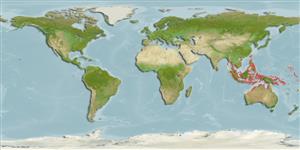>
Gobiiformes (Gobies) >
Oxudercidae (Mudskippers) > Periophthalminae
Etymology: Periophthalmodon: Greek, peri = around + Greek, ophthalmos = eye + Greek, odous = teeth (Ref. 45335).
More on author: Pallas.
Environment: milieu / climate zone / depth range / distribution range
Ekologi
laut; air tawar; payau dasar (demersal); amphidromus (Ref. 51243); kisaran kedalaman 0 - 2 m. Tropical
Indo-West Pacific: Singapore, Bedok, Changi, Pulu Obi, Pulu ayer Merbau, Banka, Sumatra, Java, Jakarta, Madura, Borneo, Celebes, Ambon, Waigeu, New Guinea, India, Peninsular Malaysia, Sarawak, and Thailand (Ref. 3178). Known from the Mekong (Ref. 12693).
Size / Weight / umur
Maturity: Lm ? range ? - ? cm
Max length : 27.0 cm TL jantan/; (Ref. 7050)
Facultative air-breathing (Ref. 126274); Found in the sea, estuaries, and lower reaches of rivers (Ref. 4833). Commonly found on muddy shores in estuaries and in the tidal zone of rivers (Ref. 12693). Lives in burrows in the mud and emerges on sunny days at low tide. Moves quickly across the mud, but can be caught with entangling nets strung above the ground or with cast-nets tossed onto the exposed mud (Ref. 12693). An amphibious air-breather that actively shuttles back and forth between rock pools and air (Ref. 31184). Gulps air at the surface of its burrow and then transports the air to the bottom of the burrow in order to aerate its eggs; preys upon fiddler crabs, insects and worms (Ref. 92840).
Life cycle and mating behavior
Kematangan | Reproduksi, perkembang biakan | Pemijahan | telur-telur | Fecundity | Larva
Kottelat, M., A.J. Whitten, S.N. Kartikasari and S. Wirjoatmodjo, 1993. Freshwater fishes of Western Indonesia and Sulawesi. Periplus Editions, Hong Kong. 221 p. (Ref. 7050)
Status IUCN Red List (Ref. 130435)
ancaman kepada manusia
Harmless
penggunaan manusia
Perikanan: nilai komersial kecil
informasi lanjut
AcuanBudidaya airprofil budidaya airStrainGenetikaElectrophoresesDiturunkanPenyakit-penyakitPengolahanNutrientsMass conversion
mitraGambarStamps, Coins Misc.Suara-suaraCiguateraKecepatanTipe renangArea insangOtolithsOtakPenglihatan / visi
Alat, peralatan
laporan khas
muat turun XML
Sumber internet
Estimates based on models
Preferred temperature (Ref.
123201): 27.5 - 29.3, mean 28.8 °C (based on 1920 cells).
Phylogenetic diversity index (Ref.
82804): PD
50 = 0.6250 [Uniqueness, from 0.5 = low to 2.0 = high].
Bayesian length-weight: a=0.01698 (0.00936 - 0.03081), b=3.04 (2.88 - 3.20), in cm total length, based on LWR estimates for this species & (Sub)family-body (Ref.
93245).
Trophic level (Ref.
69278): 3.2 ±0.4 se; based on size and trophs of closest relatives
Daya lenting (Ref.
120179): Tinggi, Waktu penggandaan populasi minimum kurang dari 15 bulan (Preliminary K or Fecundity.).
Fishing Vulnerability (Ref.
59153): Low vulnerability (17 of 100).
